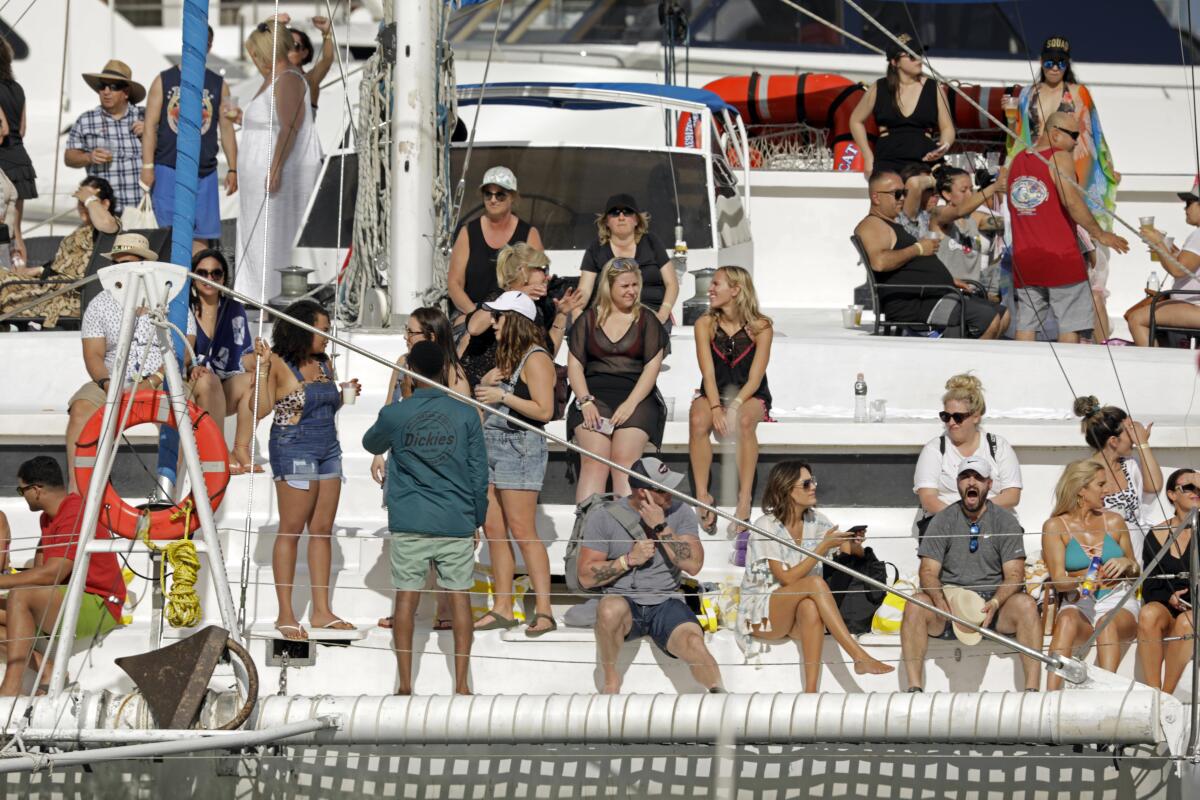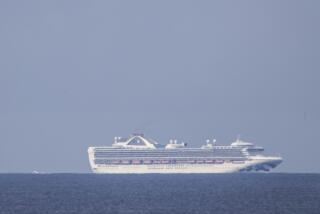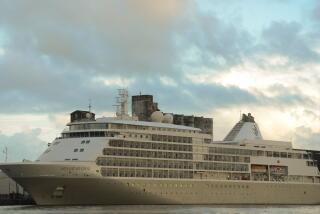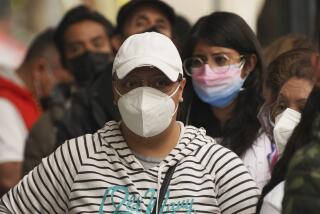Mexico plays down chance that Grand Princess spread coronavirus, but questions multiply

- Share via
CABO SAN LUCAS, Mexico — Posters and official fliers in this coastal tourist hot spot seek to allay concerns about the fast-spreading global health menace that has left victims from China to Italy to California.
“Baja California Sur is coronavirus free and that’s how we want to stay!” proclaims one sign.
But even though officials here say Baja has so far avoided the COVID-19 contagion, questions have been raised about whether passengers on the Grand Princess, a cruise ship with several infected crew members and passengers, could have either picked up or spread the coronavirus when it visited Cabo and three other Mexican Pacific ports during a Feb. 11-21 trip from San Francisco.
On Saturday, a cruise line official reported that one 75-year-old California passenger, who later died of the virus, was infected before boarding the ship on Feb. 11, and was sick several days before the boat returned to San Francisco on Feb. 21.
According to Dr. Grant Tarling, the cruise’s medical officer, the Placer County man didn’t visit the ship’s doctor until Feb. 20, but started exhibiting symptoms as early as Feb. 13. That was before the vessel made its first Mexican port stop, Feb. 16 in Puerto Vallarta. It went on to visit Manzanillo that same day, stopped in Mazatlan on Feb. 17, then anchored in Cabo San Lucas on Feb. 19.

Complicating matters, Placer County health officials have disputed Tarling’s information, saying the diseased man “likely contracted the disease during international travel to Mexico,” which could mean he contracted it on the boat or during a shore visit.
It is not publicly known if he departed the boat at any stops. What is known is that many passengers on the Grand Princess made shore visits at each port, according to persons who were part of the trip.
During its layovers at Mexican ports, “literally hundreds” of people left the ship for shore excursions, said a source on the vessel who asked not to be named for privacy reasons.
“Passengers really penetrate the port towns,” said Ter Soloman, who traveled on the Mexican voyage with his wife. “For example, in Mazatlan, tours take them to the central market, cathedral and historic theater.”
For their part, Mexican authorities have said they have found no indication that anyone who disembarked from the Grand Princess last month spread the virus — or contracted it in Mexico.
Mexico has confirmed a total of six cases of the coronavirus, although none in the state of Baja California Sur. All six cases, Mexican authorities say, are people who recently traveled to Italy, site of a major outbreak.
All the affected individuals in Mexico have exhibited minor symptoms, health authorities say, and none have been linked to the international cruise ships that frequent the country’s ports.

Yet as the Grand Princess remains held off the coast of San Francisco, the international inquiry into its current and previous passengers is just getting started. As of Friday, at least 21 people on board, including 2 passengers and 19 crew members, had tested positive, according to federal and state authorities.
After departing Mexico, the cruise ship returned to San Francisco on Feb. 21 and then departed for a trip to Hawaii. Tarling, chief medical officer for Princess Cruises, said 70 people remained on board for the Hawaii portion of the cruise.
On Friday, authorities in Hawaii confirmed that the state’s first case of the coronavirus involved a man who had been a passenger on the Grand Princess during its Mexico leg. He fell ill after flying home to Oahu from Mexico, but did not exhibit symptoms of the disease during that flight.

In Mexico, authorities say they have a health protocol in place mandating that cruise lines advise Mexican authorities in advance of any illnesses aboard ships. Passengers and crew members are only allowed to disembark once authorities review ships’ health logs, confirm the information and determine there is no threat to people on shore, Mexican officials say.
No one from the Grand Princess during its Mexico tour “presented symptoms that could have put in danger the population,” Dr. Rafael Félix Espinoza, chief health officer in Mexico’s Sinaloa state, said in a statement.
Among the Grand Princess’ four stops in Mexico was a 10-hour call in Mazatlán, Sinaloa state.
Prior to Saturday’s reports, Mexican authorities downplayed the possibility that the Placer County man displayed symptoms of the coronavirus while the ship was visiting Mexico.
“Because of the time of incubation of the virus, it is very improbable that the patient had the virus during his time in Mexican ports,” Felix Espinoza said.
In a separate case, Mexican authorities late last month allowed passengers and crew from another cruise ship — the MSC Meraviglia — to disembark in Cozumel, on the Caribbean coast, after the boat had been turned away from ports in Jamaica and Grand Cayman amid fears of a coronavirus outbreak. In that case, Mexican health authorities said tests determined that no one on board had contracted the coronavirus.
“We cannot act with discrimination,” Mexican President Andrés Manuel López Obrador told reporters when asked about the case of the MSC Meraviglia. “Imagine if a ship arrived and it wasn’t even allowed to dock, and they were told, ‘Keep going on your way, see where you can dock.’ That is inhuman.”
On a recent afternoon in Cabo San Lucas, not a mask was could be seen on tourists and tour operators shouted greetings, shook hands and jostled the arms and shoulders of visitors.
“We’re not worried,” said Tommy Wright, 67, of Tulsa, Oklahoma, who noted that he and his wife, Susan, come to Cabo a few times a year to fish and relax. “It’s a virus. … Take a look at the flu. That kills thousands of people every year. This doesn’t even come close.”
The city’s health director, Adam Monroy, said the process for investigating and containing viral threats is robust.
“This is not new,” he said referring to procedures that date from the 2009 outbreak of the H1N1 virus, or swine flu. “Our protocols work.”
Any decline in cruise ship visits could have economic implications in Mexico, which is heavily dependent on tourism.
Last year, according to official figures, 2,951 cruise ships stopped at Mexican ports, carrying almost 9 million passengers, an increase of 13.5% compared to the previous year. Cabo San Lucas hosted 204 cruise ships in 2019 with more than 500,000 passengers.
Fatima Miranda Cortés, director of tourism and economy for Cabo San Lucas, said her team has been working hard to inform people about the virus.
Last week, two residents were tested after displaying symptoms of illness after returning from Japan. According to state authorities, the results were negative.
Nonetheless, she said, the city has already taken a big economic hit as a result of coronavirus concerns.
Cruise ship reservations, she said, have dropped by 20-30%. Spring break — between March 1 and March 30 — is generally the busiest time, she said, with roughly 30 cruise ships coming into port during that period.
“So, things could get worse as the month goes on,” she said.
Despite the general lack of alarm here about the virus, some visitors have been taking extra precautions.
“We heard it was safe here,” said Naomi Alcazar, 40, who was visiting from Oxnard. “They said there’s no coronavirus. But, we’re still putting Clorox on everything. On the airplane. Everywhere.”
Her friend, Elva Rizzie, also from Oxnard, however, seemed less than pleased to be talking about it.
“I don’t want to hear it,” she said. “Go away.”
Staff writer Rust reported from Baja California, McDonnell from Mexico City and Chabria from Sacramento. Special correspondent Cecilia Sánchez in Mexico City contributed to this report.
More to Read
Sign up for Essential California
The most important California stories and recommendations in your inbox every morning.
You may occasionally receive promotional content from the Los Angeles Times.















